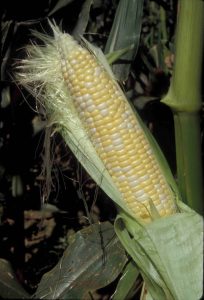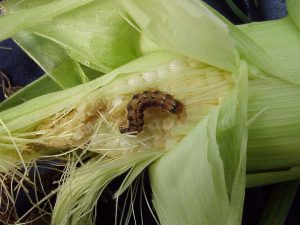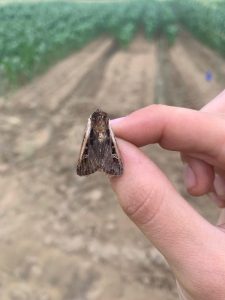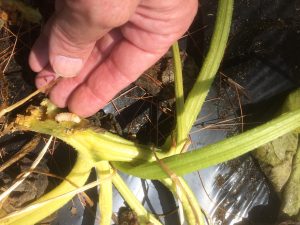Sweet Corn IPM Newsletter No. 5 – August 9, 2019

Sweet Corn IPM Newsletter No. 5 – August 9, 2019
Click on photos to enlarge.
HIGH INSECT PRESSURE FOR SILKING CORN
Corn Earworm, Fall Armyworm, Western Bean Cutworm Counts High at Most Sites
SITUATION
Weather continues to be good for sweet corn growth, with some much-needed rain helping out the drier sites this week. Insect pressure continues to be high, with corn earworm, fall armyworm and western bean cutworm over threshold at most sites, so silking corn requires protection.
European corn borer: There was no feeding injury over the 15% control threshold on pre-tassel corn this week. Very few moths were caught in traps, and were not over the threshold for silking corn at any of our sites.

Corn earworm: Moth catches continue to be high at most locations, posing a significant threat to all fresh, silking corn. A six-day spray interval for silking corn was recommended in Bowdoinham, Charleston, Nobleboro, Oxford, Palmyra and Sabattus. A five-day spray interval was recommended for silking fields in Garland, one Dayton site, New Gloucester, North Berwick and one Wells site. A four-day spray schedule was recommended in Auburn, Biddeford, Cape Elizabeth, one Dayton site, Lewiston, Levant, and Wayne.
Fall armyworm: Moth counts were over the 3-moth threshold for silking corn in Bowdoinham, Cape Elizabeth, Charleston, Garland, Dayton, Lewiston, New Gloucester, Nobleboro, Poland Spring, and Wells. Only the Poland Spring site was not also under a spray interval for corn earworm. Larval feeding damage to young corn was over the 15% spray threshold in Poland Spring and one Wells site.

Western bean cutworm: We continue to find high numbers of moths at many locations, suggesting that this insect is a significant threat to silking corn at this time. Sprays for corn earworm should protect corn from western bean cutworm as well; but if fields are not being sprayed for earworm, we suggest protecting plants from late pre-tassel to silk when western bean cutworm moth counts exceed three per week.

Squash vine borer: Moths were above the spray threshold of 5 moths in Biddeford, New Gloucester, Oxford this week, indicating that growers need to stay on the lookout for vine borer damage, and protect squash and pumpkins if moths or damage are seen.
Sprayer Calibration
Nick Rowley, Research Associate in Vegetable Production, Highmoor Farm.
Calibrating spray equipment can be a daunting task, especially to someone who has never done it. But there are good resources available to help growers with the process. Below are links on how to calibrate both air blast and boom sprayers, and advise on how improve coverage with air canon type sprayers.
Step by step guide for air blast sprayers from Ontario Ministry of Agriculture, Food and Rural Affairs: Calibrating Airblast Sprayers
Step by step calibration for band and broadcasted sprays from Ohio State University Extension: Boom Sprayer Calibration
Step by step calibration with a video from SpraySmarter.com: Easy Way to Sprayer Calibration
Improving coverage using an air cannon sprayer from Sprayers101: Spraying Sweet Corn
Sincerely,
David T. Handley
Vegetable and Small Fruit Specialist
Highmoor Farm UMaine Extension Diagnostic
P.O. Box 179 Research Lab, Pest Mgmt. Unit
52 U.S. Route 202 17 Godfrey Drive
Monmouth, ME 04259 Orono, ME 04473
207.933.2100 1.800.287.0279
Sweet Corn IPM Weekly Scouting Summary
| Location | CEW Moths |
ECB Moths |
FAW Moths |
WBC Moths |
Feeding Damage |
Recommendations / Comments |
|---|---|---|---|---|---|---|
| Auburn | 27 | 0 | 0 | 52 | 0% | 4-day spray interval for all silking corn |
| Biddeford | 20 | 0 | 2 | 16 | 9% | 4-day spray interval for silking corn |
| Bowdoinham | 3 | 0 | 10 | 3 | 0% | 6-day spray interval for all silking corn |
| Cape Elizabeth I | 26 | 1 | 16 | 13 | 8% | 4-day spray interval for silking corn |
| Cape Elizabeth II | 72 | 0 | 2 | 37 | 6% | 4-day spray interval for silking corn |
| Charleston | 3 | 0 | 3 | 0% | 6-day spray interval for all silking corn | |
| Garland | 4 | 0 | 3 | 5-day spray interval for silking corn | ||
| Dayton I | 21 | 0 | 0 | 16 | 0% | 4-day spray interval for silking corn |
| Dayton II | 7 | 1 | 19 | 12 | 3% | 5-day spray interval for silking corn, |
| Farmington | 1 | 0 | 1 | 29 | One spray for WBC on silking corn | |
| Lewiston | 38 | 0 | 7 | 78 | 4-day spray interval for all silking corn | |
| Levant | 12 | 0 | 0 | 4-day spray interval for all silking corn | ||
| New Gloucester | 7 | 0 | 10 | 12 | 0% | 5-day spray interval for silking corn, |
| Nobleboro | 3 | 0 | 10 | 7 | 0% | 6-day spray interval for all silking corn |
| No. Berwick | 6 | 3 | 1 | 3 | 0% | 5-day spray interval for all silking corn |
| Oxford | 2 | 0 | 2 | 34 | 0% | 6-day spray interval for all silking corn |
| Palmyra | 2 | 0 | 0 | 1% | 6-day spray interval for all silking corn | |
| Poland Spring | 0 | 0 | 9 | 40 | 15% | One spray for FAW (silk), feeding damage |
| Sabattus | 3 | 4 | 1 | 9 | 6-day spray interval for all silking corn | |
| Wayne | 14 | 0 | 1 | 5 | 1% | 4-day spray interval for all silking corn |
| Wells I | 1 | 0 | 1 | 11 | 16% | One spray for WBC (silk), feeding damage |
| Wells II | 5 | 0 | 11 | 7 | 3% | 5-day spray interval for all silking corn |
CEW: Corn earworm (Only fresh silking corn should be sprayed for this insect.)
ECB: European corn borer
FAW: Fall armyworm
WBC: Western bean cutworm
Corn Earworm Spray Thresholds for Pheromone Traps
| Moths caught per week | Moths caught per night | Spray interval |
|---|---|---|
| 0.0 to 1.4 | 0.0 to 0.2 | No spray |
| 1.5 to 3.5 | 0.3 to 0.5 | Spray every 6 days |
| 3.6 to 7.0 | 0.6 to 1.0 | Spray every 5 days |
| 7.1 to 91 | 1.1 to 13.0 | Spray every 4 days |
| More than 91 | More than 13 | Spray every 3 days |
Thresholds apply only to corn with exposed fresh silk. Lengthen spray intervals by one day if maximum daily temperature is less than 80°F.
European Corn Borer Thresholds
Whorl stage: 30% or more of plants scouted show injury.
Pre-tassel-silk: 15% or more of plants scouted show injury.
Silk: 5 or more moths caught in pheromone traps in one week.
IPM Web Pages:
UMaine Cooperative Extension Integrated Pest Management
Penn State Pest Watch – Sweet Corn
UMass Amherst Integrated Pest Management
Where brand names or company names are used, it is for the reader’s information. No endorsement is implied nor is any discrimination intended against other products with similar ingredients. Always consult product labels for rates, application instructions and safety precautions. Users of these products assume all associated risks.
The University of Maine is an equal opportunity/affirmative action institution.
